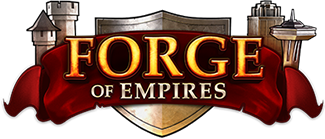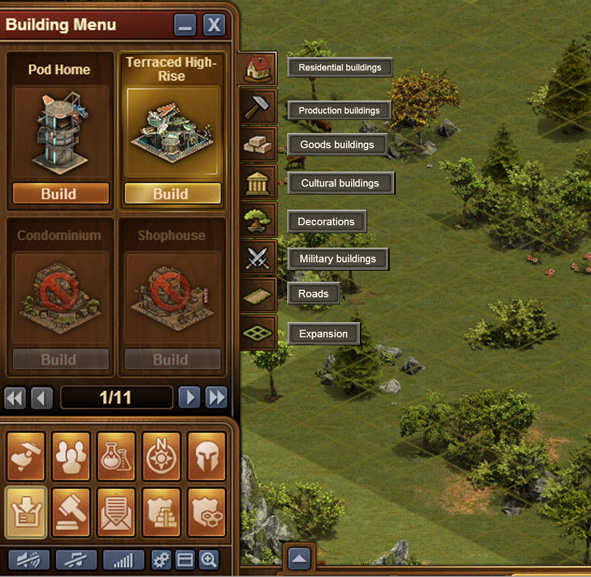Κτίρια
General info about Buildings
Buildings are the key to success in Forge of Empires. To build buildings to simply have to open the construction menu at the bottom left corner of your game screen. Buildings are sorted into different categories and you can choose them via different tabs.
Buildings have different sizes, building costs and outcome, which can vary from age to age.
You will need to connect the majority of the buildings to the Main Hall with streets, otherwise the construction won’t start and buildings won’t activate.
You can move a building around your city grid, but you can not rotate it. You can also sell any building you don’t need any more.
Town Hall
The Town Hall is the main building of the town. All buildings except decorations and some special buildings have to be connected to the Town Hall via roads. It is the only building that cannot be sold and also the only building that changes its appearance when advancing through the ages.
Residential Buildings
![]() Residential Building is the primary building that provide an amount of population and some coins in a certain amount of time. It is very important as it provides the basic condition in the game, the people and the income.
Residential Building is the primary building that provide an amount of population and some coins in a certain amount of time. It is very important as it provides the basic condition in the game, the people and the income.
Production Buildings
![]() Production buildings are important buildings that produce supplies, a primary resource. Supplies are widely used to build buildings, to train military units and to produce goods. Production buildings vary widely in size and in building cost.
Production buildings are important buildings that produce supplies, a primary resource. Supplies are widely used to build buildings, to train military units and to produce goods. Production buildings vary widely in size and in building cost.
Goods Buildings
![]() Goods Buildings are buildings that produce goods, one of the main resources of Forge of Empires. Goods are needed for researching technologies, building great buildings, and for maintenance in the Guild vs. Guild warfare. Goods can also be used to negotiate provinces. Goods can be traded with other players. As of today there are 60 different types of goods buildings in the game.
Goods Buildings are buildings that produce goods, one of the main resources of Forge of Empires. Goods are needed for researching technologies, building great buildings, and for maintenance in the Guild vs. Guild warfare. Goods can also be used to negotiate provinces. Goods can be traded with other players. As of today there are 60 different types of goods buildings in the game.
Goods Buildings have similar mechanics to those of production buildings. The player has to assign work to each building by spending some coins, some supplies and (from the modern era and later) some unrefined goods, to produce goods. There are four different production rates, 4 hours, 8 hours, 24 hours, and 48 hours, allowing different amounts of goods to be produced.
Cultural Buildings
![]() Cultural Buildings are structures that provide happiness. They work very similarly to Decorations but provides a higher amount of happiness per tile of space in the cost of being much more expensive and must be connected to a path or road.
Cultural Buildings are structures that provide happiness. They work very similarly to Decorations but provides a higher amount of happiness per tile of space in the cost of being much more expensive and must be connected to a path or road.
Decorations
![]() As with Cultural Buildings, Decorations are building structures which boost a town population's happiness at a comparatively cheaper short-term cost, but they provide less happiness per tile of space. They are the ideal choice of type in the game's early stages until emphasis on area efficiency becomes more apparent.
As with Cultural Buildings, Decorations are building structures which boost a town population's happiness at a comparatively cheaper short-term cost, but they provide less happiness per tile of space. They are the ideal choice of type in the game's early stages until emphasis on area efficiency becomes more apparent.
Military Buildings
![]() Military Buildings are buildings that can train Military Units. Each Building can only recruit one kind of unit. A Military Building has two slots unlocked by default, and you may purchase two additional slots by paying a certain amount of Gold and Supplies. There is also a fifth slot, but it can only be unlocked through Diamonds. Also take note that the price to unlock slots gets higher the more you unlock.
Military Buildings are buildings that can train Military Units. Each Building can only recruit one kind of unit. A Military Building has two slots unlocked by default, and you may purchase two additional slots by paying a certain amount of Gold and Supplies. There is also a fifth slot, but it can only be unlocked through Diamonds. Also take note that the price to unlock slots gets higher the more you unlock.
Recruiting units does not affect your Population.
Roads
![]() Roads are essentially a city's 'power lines'. With the exception of the Town Hall and decorations, all buildings must be touching a road that is connected to the Town Hall in order to produce coins, supplies, train military units, etc. Any building not touching a road with at least one of its edges will display a graphic of a broken chain above it and will cease all productivity. For players' convenience, roads may be replaced with roads of a different type by simply building over the existing road with no need to delete/sell it first. However, roads also give nothing back when sold so try to preserve them as much as possible when placing/moving buildings rather than destroying and replacing them.
Roads are essentially a city's 'power lines'. With the exception of the Town Hall and decorations, all buildings must be touching a road that is connected to the Town Hall in order to produce coins, supplies, train military units, etc. Any building not touching a road with at least one of its edges will display a graphic of a broken chain above it and will cease all productivity. For players' convenience, roads may be replaced with roads of a different type by simply building over the existing road with no need to delete/sell it first. However, roads also give nothing back when sold so try to preserve them as much as possible when placing/moving buildings rather than destroying and replacing them.
In the Progressive Era and beyond, some buildings will require a two-lane street instead of an ordinary road
Expansions
Expansions allow the player to enlarge the building area of city. One expansion unlocks an area of 4x4 tiles that has to be placed adjacent to the current building area grid. There are three ways to expand the building area: by paying with coins, by medals, or by diamonds. Expanding is crucial to increase supply and coin output. The player starts the game with 16 4x4 tile expansions.
Great Buildings
Great Buildings are special buildings inspired by world history which can be built to provide powerful benefits to the player.
Each Age offers two Great Buildings, each one with its own unique bonus, graphic, and space required to build. Unlike conventional buildings which require only coins/supplies, Great Buildings have additional requirements of goods and blueprints which must be collected before the Great Building can be constructed. Once the Great Building's requirements have been met and the foundation laid, it will be level 0 and must be "leveled" to level 1 before granting benefits to the player.
For Great Buildings to gain levels, forge points must be placed into them. For each level gained, the inherent bonus of that Great Building increases as well as rewards paid to top donors. At level 10, the Great Building will no longer advance until a full set of blue prints are traded. Once this occurs, a single level will be unlocked - this must be done for each level past 10.
Special Buildings
These buildings are special buildings that have been available for limited periods mostly during events.


